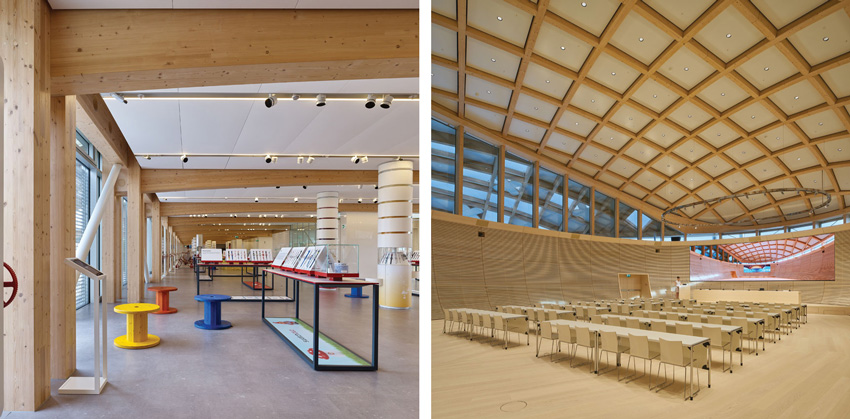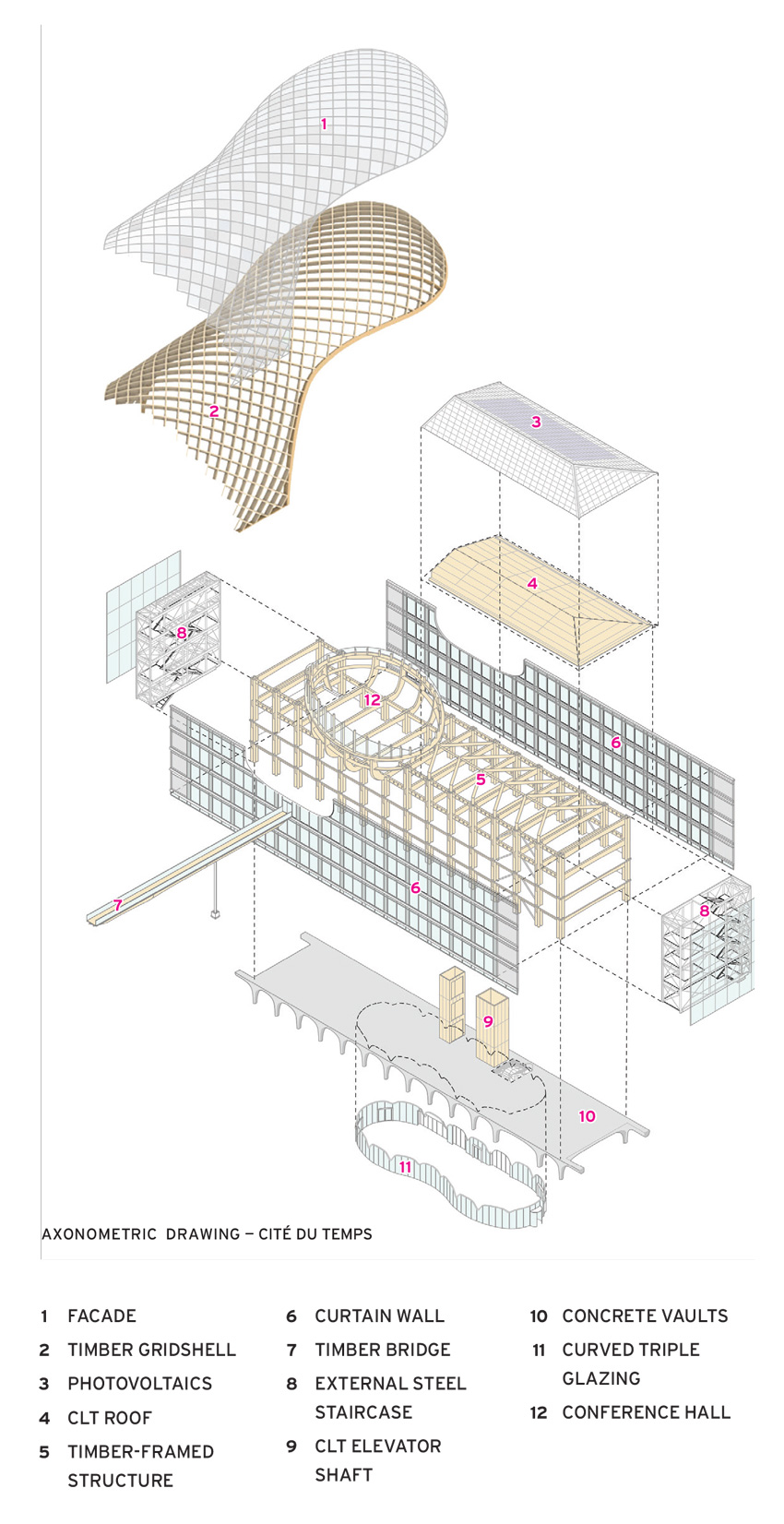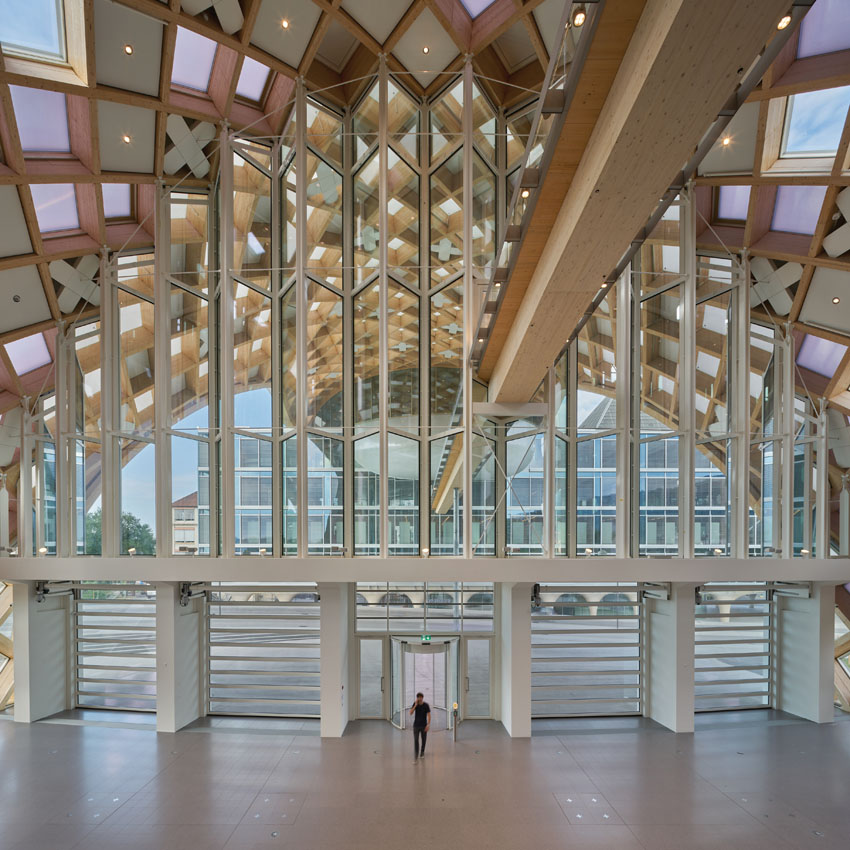Mass Timber Construction
Of course, none of the structural systems for Ban’s Biel/Bienne buildings are entirely wood. All combine timber and reinforced concrete, but in different ways. The production facility, for instance, has a central concrete core that, in addition to housing stairs, elevators, and restrooms, also includes a highly secure and automated stockroom, where 26,000 storage boxes holding movements, cases, crystals, and other watch parts are retrieved by robots. Flanking the core on either side are the daylit spaces where the watchmakers assemble the timepieces. Ventilated to near clean-room standards, these wood-framed wings depend on paired columns rising the full height of the building and placed every 18 feet. They connect to beams that span from the perimeter to the core with cylindrical dowels made of beech—a species that is harder than spruce and therefore helps create a rigid connection. This framing supports floor slabs that are a composite of timber and concrete, to limit vibrations.
The museum, which has been dubbed the Cité du Temps by the client, has a timber structure for its curtain wall–enclosed upper floors with a system based on elegant groupings of four 11-inch-square columns placed every 16 feet along the perimeter. The oval conference hall, also framed in wood, with white ash ribs cladding its interior, is partially inserted within the upper reaches of the post-and-beam structure. This complete timber assemblage is lifted off the ground with sculptural and satin-smooth concrete piloti and vaults made with laminated timber formwork that has been shaved and shaped by CNC machines. This base’s permeability and its level of finish helps signal the open nature of the museum (the only public facility in the trio of new structures), points out Taro Okabe, director of Ban’s Paris office, where the project was based.


PHOTOGRAPHY: © DIDIER BOY DE LA TOUR
CITÉ DU TEMPS A bridge and an amorphous roof connect the museum (left) to the headquarters. Inside are dramatic spaces: a lobby (right); auditorium (bottom, left); and exhibition areas (bottom, right).
The Swatch headquarters also makes use of reinforced concrete. Here it forms the slabs of the three above-grade floors, which are completely enveloped by the self-supporting, undulant gridshell. As one might intuit, this serpent-like roof was the single most complex aspect of the three-building project. But the source of the challenge was not in figuring out how to make the free-form enclosure stand up. “In terms of statics, it is a vault or an arched bridge, which are forms that are familiar and well understood,” says Blumer. He explains that the problem was instead the integration of the timber components with the building infrastructure and with the 2,800 cladding elements, all roughly 7 feet square, but all uniquely shaped, of which there are three primary types: metal panels, glass, and cushions of ETFE (a strong and lightweight fluorine-based plastic). In addition to grappling with the variation, the design team also had to understand the unique thermal behavior of each material and how to accommodate cutouts for building infrastructure, including power, sprinklers, and the building automation network, but without compromising the structural integrity.

The initial cladding scheme was much more straightforward. In the competition submittal, the headquarters was almost entirely covered with the ETFE cushions. “We wanted to make the skin as light as possible,” says Ban. At that early stage, the depth of the timber and facade assembly was only about 35 inches. But, once the architects confronted such practicalities as the incorporation of radiant heating and cooling ceiling panels, the need for noise control (ETFE is a poor acoustic barrier), as well as compliance with Swiss labor regulations that required the inclusion of vision glass, the number of cladding types grew, as did the thickness of the envelope—to a hefty 55 inches. The increased dimension threatened Ban’s concept for the project, but also reduced the occupiable interior space, due to the site’s zoning restrictions.











